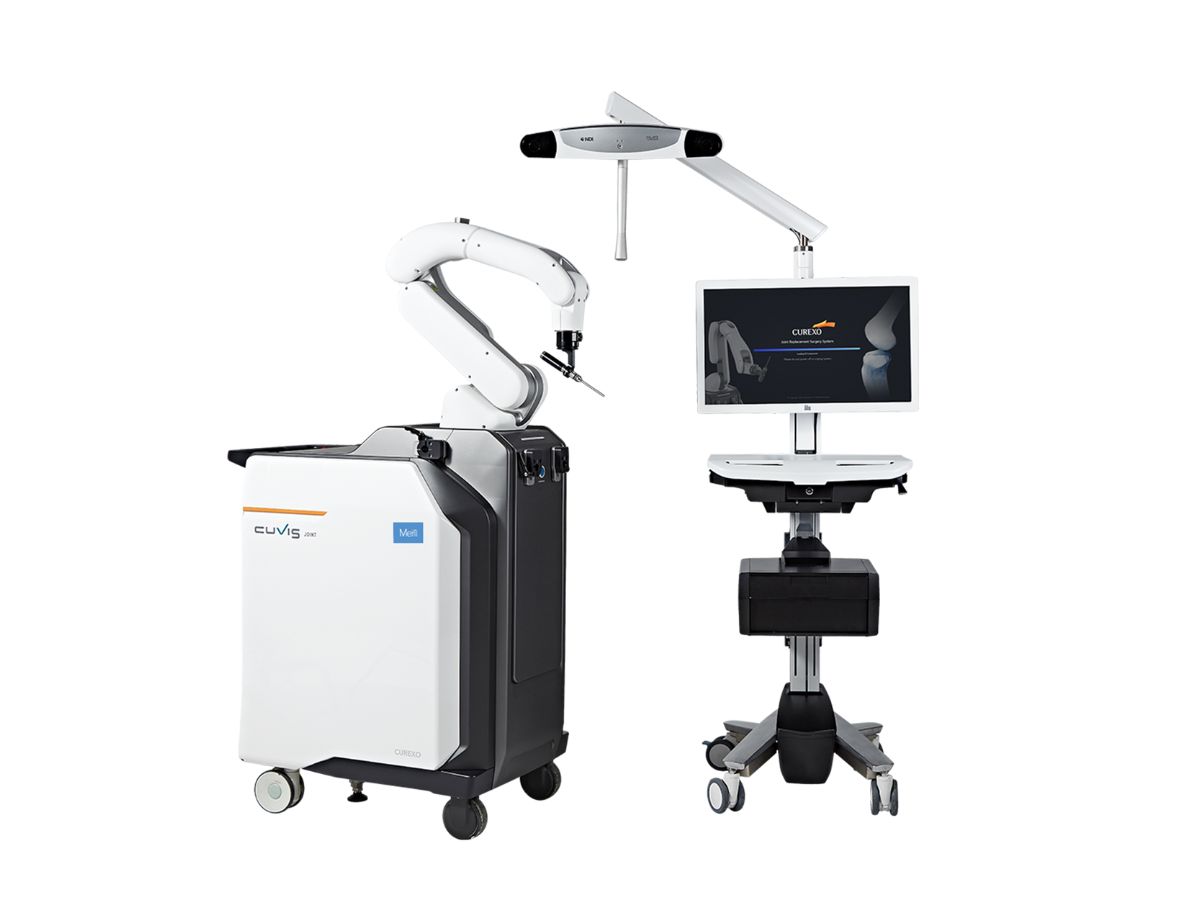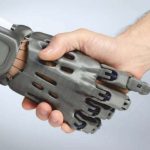A more precise, less invasive surgical option for painless and faster recovery
“Wear-and-tear ahritis, osteoahritis is the most common culprit in joint pain. It occurs when the lining of the joints, called cartilage, is worn down. Genetics, unhealthy body weight, joint injury or overuse, and smoking are all factors that may put you at greater risk,” says, Dr Shetty (Director Roboplasty, Robotic Knee Replacement Clinics India)
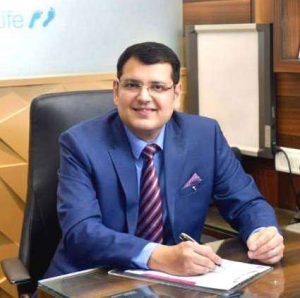 Arthritis affects a person’s overall function and mobility and is a leading cause of work disability posing a huge societal burden. To discuss on this rising cause of disability we spoke to Dr Santosh Shetty a world-renowned master robotic joint replacement surgeon from India. The global prevalence of hip and knee osteoarthritis soared to more than 300 million cases in 2017, nearly all occurring in high income countries and the number is expected to rise as per the analysis conducted by the Institute of Health Metrics and Evaluation for 195 countries in order to determine incidences of new and present cases for the knee and hip joints. Furthermore, there is evidence that women are particularly affected by this condition. Osteoarthritis linked to these areas accounts for considerable treatment and care costs.
Arthritis affects a person’s overall function and mobility and is a leading cause of work disability posing a huge societal burden. To discuss on this rising cause of disability we spoke to Dr Santosh Shetty a world-renowned master robotic joint replacement surgeon from India. The global prevalence of hip and knee osteoarthritis soared to more than 300 million cases in 2017, nearly all occurring in high income countries and the number is expected to rise as per the analysis conducted by the Institute of Health Metrics and Evaluation for 195 countries in order to determine incidences of new and present cases for the knee and hip joints. Furthermore, there is evidence that women are particularly affected by this condition. Osteoarthritis linked to these areas accounts for considerable treatment and care costs.
Dr Santosh Shetty has been providing toptier treatments to those suffering from hip and knee pain, with the goal of giving them mobility and a life free of pain. Dr Shetty performs Robotic Joint Replacement in Mumbai, India at CritiCare Asia Hospital, and over the past 21 years has been integral in teaching young surgeons the science of joint replacement, with over 50 trained orthopaedic surgeons now practicing internationally.
Dr Shetty has consistently kept up with the most cutting-edge technology too; his dedication to arthritis and joint pain management has earned him multiple awards, such as the ‘Safe Practice Award’ in 2022. The award is a testament to Dr Shetty’s commitment to providing patients with the safest care possible.
As a world-leading surgeon, Dr Shetty has been honored for his invaluable contributions to management of arthritic and joint pain treatments. Recently, he became the first doctor in the world to perform a single-stage robotic cruciate retaining total knee replacement for both knees with an automatic robotic arm technology’s help and Opulent Gold Implants coated with a special material.
Notably, Dr Shetty was presented with the prestigious Maharashtra Gaurav Award for his exemplary work in the field of robotic joint replacements. In recognition of this victory, we asked him to enlighten us on advancements in joint replacements and his thoughts on different types of surgical options as well as robots’ roles in joint replacements.
Tell us in detail what are the common causes of knee joint pain?
Wear-and-tear arthritis, osteoarthritis is the most common culprit in joint pain. It occurs when the lining of the joints, called cartilage, is worn down. Genetics, unhealthy body weight, joint injury or overuse, and smoking are all factors that may put you at greater risk.
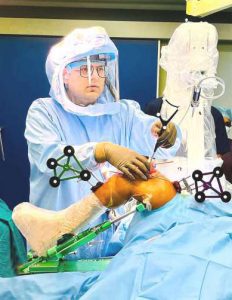 What are the common things a patient should know before undergoing Robotic joint replacement surgery?
What are the common things a patient should know before undergoing Robotic joint replacement surgery?
Robotic joint replacement is a type of surgery that is becoming increasingly popular. This form of surgery involves the use of a robot to help place the new joint in a proper alignment. There are many benets to this type of surgery, including a shorter hospital stay, less pain, and a quicker recovery.
There are a few things that patients should know before undergoing robotic joint replacement surgery. First, anyone who is fit for a normal surgery is fit for a robotic surgery too. Second, the surgery is minimally invasive, meaning that there will be smaller incisions and less scarring
What are the advantages of robotic surgery?
Robotic surgery has become increasingly popular in recent years, as technological advances have made it more precise and less invasive than traditional surgery. There are many advantages to robotic surgery, including better implant positioning, less human intervention, faster recovery, and shorter hospital stays. Additionally, the minimally invasive nature of robotic surgery results in less tissue trauma, less blood loss, and a quicker recovery. These advantages make robotic surgery an appealing option for patients and surgeons alike.
You are one of the early adapters of robotic knee replacement. What are the benets of this to patients?
The benets of robotic knee replacement surgery include more accurate and precise implant positioning, less blood loss, quicker recovery times, and better long-term results. Robotics technology is also assumed to be safer due to the elimination of human error.
What are the types of implants and how long do they last
There are two types of implants commonly used: those made of Cobalt Chromium (COCr) and those made of Titanium Niobium Nitride (TNN). COCr implants usually last for 15 to 20 years, while TNN implants can last up to 30 years. Younger, active patients or those with metal allergies may prefer the TNN implants.
What is your experience with the Robotic Technology?
Robotic technology is a revolutionary technology that has revolutionized the medical industry. This technology has been a boon to all patients of all age, even those with high risk & of age more than 90 yrs. Robotic Replacement can be lifesaving too as it reduces the risk of fat embolism and is the safest available technology. Patients who have undergone Robotic Replacement have expressed that it is has been a life changing experience. This technology has been a life saver for many patients and has helped them lead a normal life.
What is the key factor to a successful robotic joint replacement surgery?
The skills and experience of a surgeon, as well as the availability of the latest advanced third generation robotic technology, play a key role. Overall, aseptic precautions taken by the team and the center to reduce the risk of infection and readmissions are the pillars of a successful joint replacement surgery.
What is the importance of expert opinion in this type of surgery?
As a joint pain patient, it is important to get an expert opinion to ensure that you are getting the best possible treatment. This is where our services come in. We offer zoom video consultation, online consultation, and our services are also available through Face Time, Google meet, whatsapp, telegram, email, and various other platforms. This allows you to get the help you need from the comfort of your own home.
As someone who has been doing joint replacement surgery with different techniques and technologies for years, I can attest to its lifechanging effects. Not only is it one of the safest surgeries with a good success rate, but it can greatly improve your quality of life. Age is no barrier to surgery, and anyone suffering from joint pain and arthritis, especially those who are finding it difficult to continue with their daily routine activities or who have deformities, should not hesitate to consider a robotic joint replacement surgery. The surgery greatly improves mobility and allows to return to the activities one enjoys. I would encourage anyone considering joint replacement surgery to go for it – you won’t regret it!
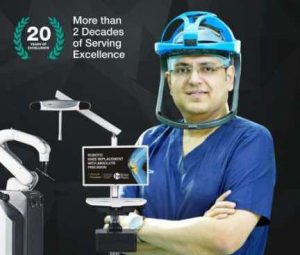 Why should patients choose your center?
Why should patients choose your center?
We are one of the few centers in South Asia to have chosen two third generation surgical robots. A combination of two different types of robots, helps us provide the best surgical care to the patient by selecting the patient specific implant and surgical technique.
We are proud to be one of the few recognised centers of excellence for both specially coated implants and cobalt chromium high flexion cruciate retaining knee replacement surgery. This means that we offer our patients the latest and best possible care, ensuring a painless experience and a fast recovery. Our patients can start walking within a few hours of surgery and usually have a short stay in hospital. We offer different types of implants to our patients, as well as different advanced t hird generation robots, depending on the individual needs of our patients. This allows us to tailor each surgery to the specific needs of the patient, ensuring the best possible outcome making it patient specific surgery.
hird generation robots, depending on the individual needs of our patients. This allows us to tailor each surgery to the specific needs of the patient, ensuring the best possible outcome making it patient specific surgery.
We at our clinic strive to ensure that there is zero human error, zero infection rate and long term better survivorship of implants thus reducing the risk of revision surgeries. We offer our patients the Absolute Precision Technique where in their incision is very small (minimally invasive surgery), muscles are not cut at all (Subvastus Technique), ligament is saved (Cruciate Retaining Technique), bone preserving technique (Cruciate Retaining Implants), and sutureless technique with fast track recovery program and early discharge.





